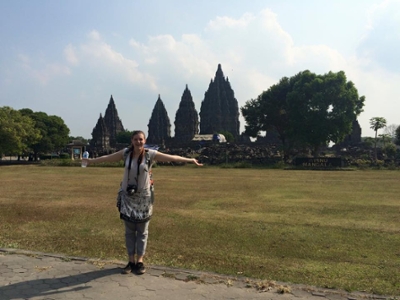Yogyakarta II
After visiting Borobudur, my sister and I checked out of our hotel and walked to the nearest bus station. We asked a few locals in broken Bahasa which bus we should take to get to Prambanan. They pointed to a bus that had clearly seen better days, with rusted spots in the floor and tattered seat cushions. We climbed aboard the empty bus and waited with no idea when it would leave or exactly where it would take us. Finally a few more passengers and the bus driver arrived and we took off. The next three hours involved a drive first through the countryside outside Yogyakarta, full of idyllic rice patties, and then several bus transfers in the city proper before we reached our destination.

The Prambanan Temple complex was far larger than either of us expected. There are actually three sites two of which are Buddhist, and the main one that is the largest Hindu temple in Indonesia. The myth is that all of the temples were built over the course of one night, but in reality they were constructed over many years with continued expansion projects in the 8th and 9th century.
We first visited Candi Sewu, the second largest Buddhist Temple in Indonesia. It predates the nearby Hindu temple by 70 years and Borobudur by 37 years. There used to be 249 temples, but all but a few now sit in piles of rubble. The Dutch reconstructed the main temple in the early 1900s and began work on the others, but some have since received damage from an earthquake that occured in 2006.
On our way walking to Candi Pramabanan, we passed by a few other destroyed Buddhist temples where all that remain are the foundation. There are continued efforts to reconstruct the temples, but it requires immense amounts of funding and time. Looting by thieves and archaeologists over the years also makes the already difficult puzzle of reconstruction even more complicated.

Candi Pramabana represents one of the more successful reconstruction efforts. It was rediscovered by the British during their brief domination of Java in 1811. Reconstruction wasn’t started, however, until the 1930s by the Dutch, and a number of the temples are still being reassembled today. The largest of the temples is dedicated to Shiva, and the other two main temples are dedicated to Visnu and Brahma. The smaller three temples are dedicated to the gods’ vahana, their mounts. Shiva rides on a cow, Brahma a swan, and Visnu a humanoid bird called garuda (also the name of Indonesia’s main airline). The main Shaivite temple reaches over 150 feet into the air, with steep steps leading up to reliefs that depict the story of Ramayana, a Sanskrit epic poem.

My sister and I spent several hours wandering around the vast complex. It is incredible that the Dutch, Indonesian government, and UNSECO have been able to save so much of the temples, but it was still disheartening to see the mass amount of history that has fallen to disarray over the years. The visual arts of the medieval Hindu and Buddhist Javanese is so unlike anything I’d ever seen in person before. My hope is that in time Indonesia is able to fully restore all of its historical relics.